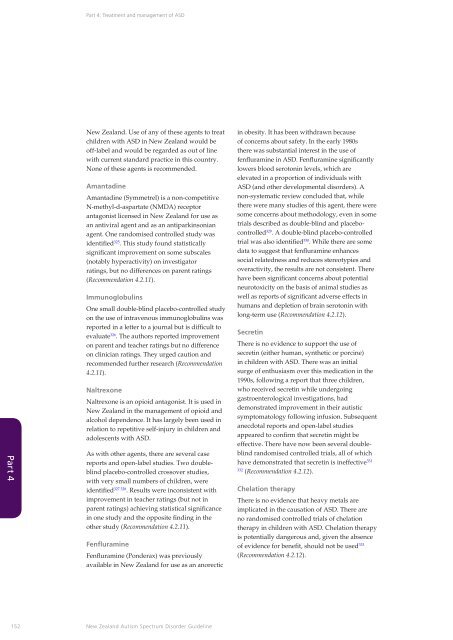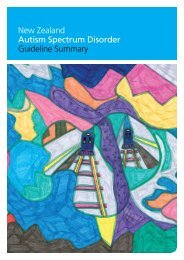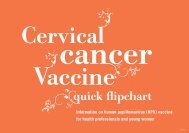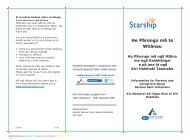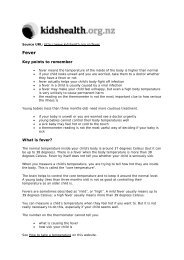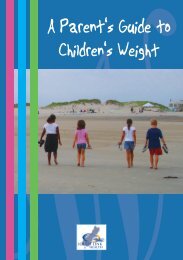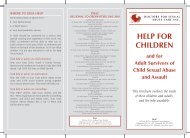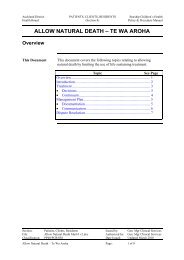New Zealand Autism Spectrum Disorder Guideline - Ministry of Health
New Zealand Autism Spectrum Disorder Guideline - Ministry of Health
New Zealand Autism Spectrum Disorder Guideline - Ministry of Health
Create successful ePaper yourself
Turn your PDF publications into a flip-book with our unique Google optimized e-Paper software.
Part 4: Treatment and management <strong>of</strong> ASD<br />
Part 4<br />
<strong>New</strong> <strong>Zealand</strong>. Use <strong>of</strong> any <strong>of</strong> these agents to treat<br />
children with ASD in <strong>New</strong> <strong>Zealand</strong> would be<br />
<strong>of</strong>f-label and would be regarded as out <strong>of</strong> line<br />
with current standard practice in this country.<br />
None <strong>of</strong> these agents is recommended.<br />
Amantadine<br />
Amantadine (Symmetrel) is a non-competitive<br />
N-methyl-d-aspartate (NMDA) receptor<br />
antagonist licensed in <strong>New</strong> <strong>Zealand</strong> for use as<br />
an antiviral agent and as an antiparkinsonian<br />
agent. One randomised controlled study was<br />
identified 325 . This study found statistically<br />
significant improvement on some subscales<br />
(notably hyperactivity) on investigator<br />
ratings, but no differences on parent ratings<br />
(Recommendation 4.2.11).<br />
Immunoglobulins<br />
One small double-blind placebo‐controlled study<br />
on the use <strong>of</strong> intravenous immunoglobulins was<br />
reported in a letter to a journal but is difficult to<br />
evaluate 326 . The authors reported improvement<br />
on parent and teacher ratings but no difference<br />
on clinician ratings. They urged caution and<br />
recommended further research (Recommendation<br />
4.2.11).<br />
Naltrexone<br />
Naltrexone is an opioid antagonist. It is used in<br />
<strong>New</strong> <strong>Zealand</strong> in the management <strong>of</strong> opioid and<br />
alcohol dependence. It has largely been used in<br />
relation to repetitive self-injury in children and<br />
adolescents with ASD.<br />
As with other agents, there are several case<br />
reports and open-label studies. Two doubleblind<br />
placebo-controlled crossover studies,<br />
with very small numbers <strong>of</strong> children, were<br />
identified 327 328 . Results were inconsistent with<br />
improvement in teacher ratings (but not in<br />
parent ratings) achieving statistical significance<br />
in one study and the opposite finding in the<br />
other study (Recommendation 4.2.11).<br />
Fenfluramine<br />
Fenfluramine (Ponderax) was previously<br />
available in <strong>New</strong> <strong>Zealand</strong> for use as an anorectic<br />
in obesity. It has been withdrawn because<br />
<strong>of</strong> concerns about safety. In the early 1980s<br />
there was substantial interest in the use <strong>of</strong><br />
fenfluramine in ASD. Fenfluramine significantly<br />
lowers blood serotonin levels, which are<br />
elevated in a proportion <strong>of</strong> individuals with<br />
ASD (and other developmental disorders). A<br />
non-systematic review concluded that, while<br />
there were many studies <strong>of</strong> this agent, there were<br />
some concerns about methodology, even in some<br />
trials described as double-blind and placebocontrolled<br />
329 . A double-blind placebo-controlled<br />
trial was also identified 330 . While there are some<br />
data to suggest that fenfluramine enhances<br />
social relatedness and reduces stereotypies and<br />
overactivity, the results are not consistent. There<br />
have been significant concerns about potential<br />
neurotoxicity on the basis <strong>of</strong> animal studies as<br />
well as reports <strong>of</strong> significant adverse effects in<br />
humans and depletion <strong>of</strong> brain serotonin with<br />
long-term use (Recommendation 4.2.12).<br />
Secretin<br />
There is no evidence to support the use <strong>of</strong><br />
secretin (either human, synthetic or porcine)<br />
in children with ASD. There was an initial<br />
surge <strong>of</strong> enthusiasm over this medication in the<br />
1990s, following a report that three children,<br />
who received secretin while undergoing<br />
gastroenterological investigations, had<br />
demonstrated improvement in their autistic<br />
symptomatology following infusion. Subsequent<br />
anecdotal reports and open-label studies<br />
appeared to confirm that secretin might be<br />
effective. There have now been several doubleblind<br />
randomised controlled trials, all <strong>of</strong> which<br />
have demonstrated that secretin is ineffective 331<br />
332<br />
(Recommendation 4.2.12).<br />
Chelation therapy<br />
There is no evidence that heavy metals are<br />
implicated in the causation <strong>of</strong> ASD. There are<br />
no randomised controlled trials <strong>of</strong> chelation<br />
therapy in children with ASD. Chelation therapy<br />
is potentially dangerous and, given the absence<br />
<strong>of</strong> evidence for benefit, should not be used 333<br />
(Recommendation 4.2.12).<br />
152<br />
<strong>New</strong> <strong>Zealand</strong> <strong>Autism</strong> <strong>Spectrum</strong> <strong>Disorder</strong> <strong>Guideline</strong>


